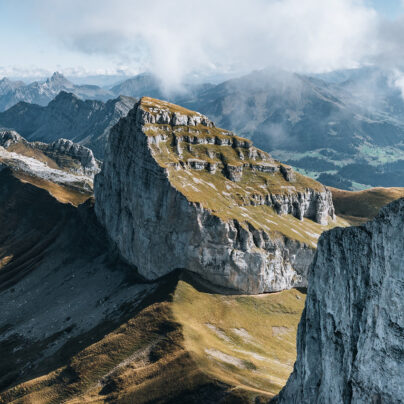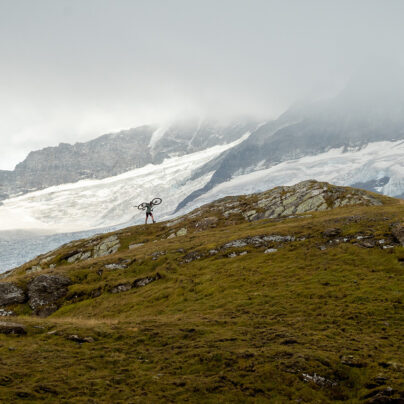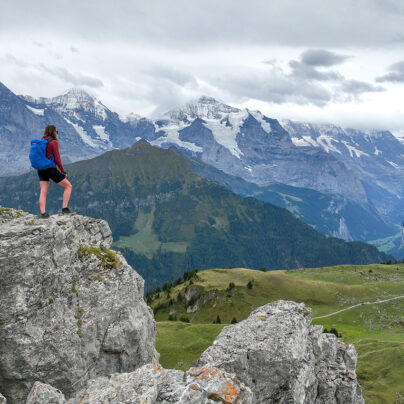Rolling the Dice
Weather gambling in Iceland
Tom McNally
The sound of the anchor startled me awake. Less than a metre from my head, through the paper-thin cabin walls, I could hear the motor straining as the heavy chain rattled deafeningly upward. I glanced blearily at my watch – 6.00am. It was a good two hours before we were due to set sail. Gusty katabatic winds rushing down from the mountains had caused us to drag anchor on several occasions the previous night. I pictured Captain Oli in the wheelhouse and Laki on deck above me, stoically going through the tiresome routine of resetting it. I waited for the din to end and rolled over to enjoy the few minutes’ snooze I had while they prospected for a better spot. I knew the chain would rattle even more loudly on the way back down.
The next time I opened my eyes I was instantly wide awake. There had been no second rattle of the chain. The pitch of the engine and familiar soporific roll signalled that we were at sea. I dressed as quickly as one can in a space no bigger than a single wardrobe pitching from side to side and hurried on deck. The view that greeted me was so astounding it actually made me step backwards. Beyond the bow, wind-whipped waves glistened in sunlight as we entered a wide fjord. At its head lay mountains iced with spotless spring snow, cascading downward in decorative zebra stripes to the water’s edge. On the starboard side lay a huge rock buttress over which backlit orographic clouds poured down from the plateau like liquid nitrogen. I stared dumbfounded at this wind-powered kaleidoscope of sun and cloud for some time before dashing below decks to grab my camera and tripod. I glimpsed Oli standing in the wheelhouse as I passed and he flashed me a grin almost as broad as my own.
It wasn’t long before the technicalities of time-lapsing the tumbling clouds from a constantly pitching boat had defeated me, and I frustratingly filed the breathtaking vista under the mental heading of ‘better remembered than recorded’. Bustling activity greeted me back below decks. Ten people were organising ski equipment and making lunch in a space no bigger than a large garden shed. It would have been a familiar scene in a cramped mountain hut but not aboard a sailing yacht.
The 18m-long Arktika had served us well as a sturdy mobile base camp from which we could explore Iceland’s northernmost peninsula, the Hornstrandir Nature Reserve, on skis. Jutting precariously into the North Atlantic, this wild place is entirely uninhabited and unspoilt, one of Europe’s last wilderness areas. Our steel-hulled floating home felt reassuringly solid, built for the rigours of sailing in northern latitudes. The Arktika was elegant and well proportioned in its durable simplicity, immediately appealing to anyone with an eye for practical design and a desire to travel through far-flung places in relative comfort.
Beyond the bow, wind-whipped waves glistened in sunlight as we entered a wide fjord. At its head lay mountains iced with spotless spring snow, cascading downward in decorative zebra stripes to the water’s edge.



The ground was awkward and sapped our energy, particularly in ski boots. Sharp angular scree pushed us off balance and volcanic gravel wet with snowmelt swallowed our steps as if it were bog.
It was a short and rather unusual expedition for me. A group from the south of England with little ski-touring experience had decided to go all-in, organising a remote and immersive baptism of fire aboard the legendary Arktika. They were unrelentingly enthusiastic, polite, and team oriented, possessing boundless levels of positivity. With my experience of photographing and writing about Iceland from previous trips, my role would be to document our journey. I said yes without hesitation and cleared my diary.
We had so far undertaken a series of ski tours from fjord to fjord, each time venturing further into the mountains before skiing down to our trusty seagoing home, each time anchored in a new setting. Iceland’s formidable weather had been kind to us – a manageable mix of wind, rain, and snow, with just the right amount of challenge but nothing truly character building. We’d spent only one full day solely aboard the boat, playing cards and drinking Icelandic lager, waiting for the wind to abate. Considering our precarious location and only 10 days in country, we had been lucky to sneak between the swirling low-pressure systems that smash into Iceland’s northerly coastline, often with barely a lull between them. It was a big gamble that was currently paying off.
We retrieved our comfortingly warm and dry boot inners, skins, and gloves from the engine room, and the daily cacophony of plastic clacking on deck began as everyone excitedly thumped feet down into ski boots and ratcheted up buckles. The novelty of gearing up in the middle of a fjord was far from wearing off. Knowing the routine, those of us ready first carefully loaded the dinghy with skis before even more carefully climbing down into the tiny rocking inflatable, ski boots skittering on the rungs of the ladder. With the water temperature just above freezing, falling in didn’t bear thinking about. The moment the last person sat down, Oli pushed off from the Arktika, clicked the outboard into gear and sat down in one seamless movement, then confidently steered us straight into the heart of the landscape that had knocked me backwards earlier that morning. In the reflections of the sunglasses of those sitting opposite, all I could see were beaming grins as we happily bounced across the fjord, spattered with sunlit spray.
The instant we started to gain height, my sunglasses steamed up and sweat began plopping onto my skis as they slid upward. Spring had most definitely taken hold in Hornstrandir. A halt was called and everyone gratefully stripped down to base layers. I squinted up at the topography between us and the summit of Bláhnjúkur – the highest point in the Westfjords. Rolling convex slopes shimmered hazily in the heat. The risk of avalanche and cornice collapse was rising as quickly as the temperature and I could see our guides Laki and Lani standing to one side, quietly discussing the many suspect terrain features that lay ahead.
Over the next few hours we cautiously weaved a route between the steeper slopes, sticking to ridgelines where possible. At one point we strapped skis to our rucksacks and ascended a rocky crest rather than committing to the glistening gradients either side. The ground was awkward and sapped our energy, particularly in ski boots. Sharp angular scree pushed us off balance and volcanic gravel wet with snowmelt swallowed our steps as if it were bog. The ridge did however offset the underfoot discomfort with a welcome breeze and spectacular views.





After cresting the ridge we swished ever higher on blinding white slopes, skirting huge faces iced with marshmallow cornices to gain a lofty plateau. The gradient eased and there was no more up to go.
For months before the trip I had visions of skiing swathes of immaculate spring snow, above shimmering fjords and beneath bluebird skies, deep in an immense mountainscape. Of course, having been to Iceland before, I also realised that this outcome was not particularly likely. Howling tempests, towering waves, and leaden skies interrupted my daydreams. It had always been feasible that we might not even step foot onto the peninsula, never mind into our bindings. Yet here we were, snow and sea twinkling, the coastline stretching out far before us and hardly a breath of wind.
The descent was straight out of my wildest expectations, but with the added authenticity of burning thighs and a soundtrack of heavy breathing. A welcome respite came as we clicked out of our bindings and shouldered skis to carefully descend a rocky gully. The warm spring temperatures of previous weeks were taking their toll, necessitating some cunning route finding. We set off steeply again, negotiating huge chasms in the snow that revealed a roaring stream beneath. As the Arktika came into view it was decision time. Which route would lead all the way to the water’s edge and complete the final piece of the puzzle? Once committed we tore down the final ribbons of snow, whoops echoing off rock faces as we careered across patches of grass and arrived successfully back at the fjord, sweaty, breathless, and elated. Oli, now resplendent in a pirate hat, was waiting to taxi us back to the Arktika.
The lengthy daylight hours normally meant a quick turnaround after food, straight back into the dinghy for more skiing until late evening. This was to be our last day on skis, but the Arktika crew suggested an exploration of the valley above Hrafnsfjordur on foot. Itching for every last drop of skiing possible, it was difficult to put our scepticism to one side – but local knowledge always counts for a lot.
There aren’t enough superlatives to describe where we found ourselves sitting a few hours later, with a stunning waterfall on one side and the river snaking a sinuous line down one of the most sublime valleys I have ever seen on the other. Looking around at the team, contented in the evening sunshine and regaled by Laki’s Icelandic folk tales, it was obvious. This trip was a winning hand.

Tom McNally is an adventure sports and travel photographer. He lives with his wife and two sons in the Lake District, England. As a founder member of The Adventure Media Company, he is a jack of all trades when it comes to outdoor pursuits, particularly enjoying travelling through wild places by human power. He also volunteers as a member of Keswick Mountain Rescue Team
Website: www.tommcnally.co.uk
Facebook: /Tom-McNally-Photography
Instagram: @tommcnallyphotography
Tom would like to thank Aurora Arktika and Joro Experiences for making this trip possible.







